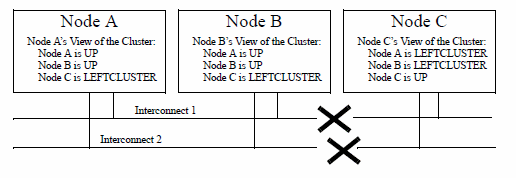Each node in a CF cluster keeps track of the state of the other nodes in the cluster. For example, the other node's state may be UP, DOWN, or LEFTCLUSTER.
LEFTCLUSTER is an intermediate state between UP and DOWN, which means that the node cannot determine the state of another node in the cluster because of a break in communication.
For example, consider the three-node cluster shown in
Figure 5.1 Three-node cluster with working connections

Each node maintains a table of what states it believes all the nodes in the cluster are in.
Now suppose that there is a cluster partition in which the connections to Node C are lost. The result is shown in the following figure.
Figure 5.2 Three-node cluster where connection is lost

Because of the break in network communications, Nodes A and B cannot be sure of Node C's true state. They therefore update their state tables to declare that Node C is in the LEFTCLUSTER state. Likewise, Node C cannot be sure of the true states of Nodes A and B, so it marks those nodes as being in the LEFTCLUSTER in its state table.
Note
LEFTCLUSTER is a state that a particular node believes other nodes are in. It is never a state that a node believes that it is in. For example, in, "Figure 5.2 Three-node cluster where connection is lost" each node believes that it is UP.
The purpose of the LEFTCLUSTER state is to warn applications which use CF that contact with another node has been lost and that the state of such a node is uncertain. This is very important for RMS.
For example, suppose that an application on Node C was configured under RMS to fail over to Node B if Node C failed. Suppose further that Nodes C and B had a shared disk to which this application wrote.
RMS needs to make sure that the application is, at any given time, running on either Node C or B but not both, since running it on both would corrupt the data on the shared disk.
Now suppose for the sake of argument that there was no LEFTCLUSTER state, but as soon as network communication was lost, each node marked the node it could not communicate with as DOWN. RMS on Node B would notice that Node C was DOWN. It would then start an instance of the application on Node C as part of its cluster partition processing. Unfortunately, Node C isn't really DOWN. Only communication with it has been lost. The application is still running on Node C. The applications, which assume that they have exclusive access to the shared disk, would then corrupt data as their updates interfered with each other.
The LEFTCLUSTER state avoids the above scenario. It allows RMS and other application using CF to distinguish between lost communications (implying an unknown state of nodes beyond the communications break) and a node that is genuinely down.
When SF notices that a node is in the LEFTCLUSTER state, it contacts the previously configured Shutdown Agent and requests that the node which is in the LEFTCLUSTER state be shut down. With PRIMECLUSTER, a weight calculation determines which node or nodes should survive and which ones should be shut down. SF has the capability to arbitrate among the shutdown requests and shut down a selected set of nodes in the cluster, such that the subcluster with the largest weight is left running and the remaining subclusters are shutdown.
In the example given, Node C would be shut down, leaving Nodes A and B running. After the SF software shuts down Node C, SF on Nodes A and B clear the LEFTCLUSTER state such that Nodes A and B see Node C as DOWN. Refer to the Chapter "Chapter 7 Shutdown Facility" for details on configuring SF and shutdown agents.
Note
Note that a node cannot join an existing cluster when the nodes in that cluster believe that the node is in the LEFTCLUSTER state. Therefore, any nodes in LEFTCLUSTER state have to be recovered before they can join an existing cluster.